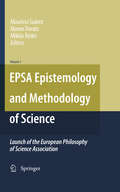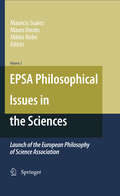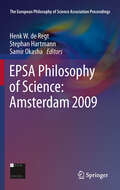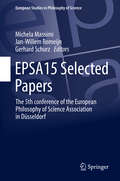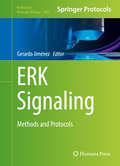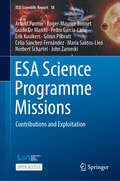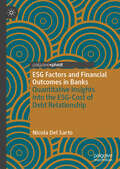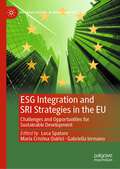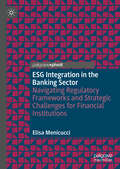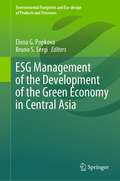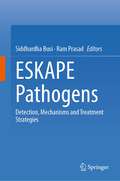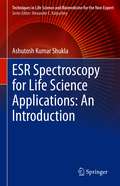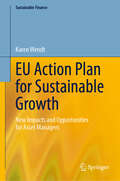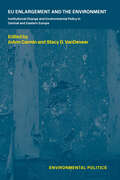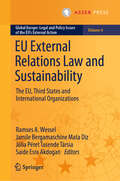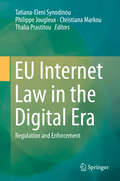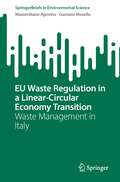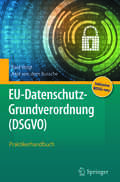- Table View
- List View
EPSA Epistemology and Methodology of Science
by Mauricio Suárez Miklós Rédei Mauro DoratoThese volumes collect a selection of papers presented at the Founding Conference of the European Philosophy of Science Association meeting in Madrid. The volumes provide an excellent overview of the state of the art in philosophy of science as practised nowadays in different European countries.
EPSA Philosophical Issues in the Sciences
by Mauricio Suárez Miklós Rédei Mauro DoratoThese volumes collect a selection of papers presented at the Founding Conference of the European Philosophy of Science Association meeting in Madrid. The volumes provide an excellent overview of the state of the art in philosophy of science as practised nowadays in different European countries.
EPSA Philosophy of Science: Amsterdam 2009
by Samir Okasha Henk W. de Regt Stephan HartmannThis is a collection of high-quality research papers in the philosophy of science, deriving from papers presented at the second meeting of the European Philosophy of Science Association in Amsterdam, October 2009.
EPSA11 Perspectives and Foundational Problems in Philosophy of Science
by Dennis Dieks Vassilios KarakostasThis book contains a selection of original conference papers covering all major fields in the philosophy of science, that have been organized into themes. The first section of this volume begins with the formal philosophy of science, moves on to idealization, representation and explanation and then finishes with realism, anti-realism and special science laws. The second section covers the philosophy of the physical sciences, looking at quantum mechanics, spontaneous symmetry breaking, the philosophy of space and time, linking physics and metaphysics and the philosophy of chemistry. Further themed sections cover the philosophies of the life sciences, the cognitive sciences and the social sciences. Readers will find that this volume provides an excellent overview of the state of the art in the philosophy of science, as practiced in different European countries.
EPSA15 Selected Papers
by Gerhard Schurz Michela Massimi Jan-Willem RomeijnThis edited collection showcases some of the best recent research in the philosophy of science. It comprises of thematically arranged papers presented at the 5th conference of the European Philosophy of Science Association (EPSA15), covering a broad variety of topics within general philosophy of science, and philosophical issues pertaining to specific sciences. The collection will appeal to researchers with an interest in the philosophical underpinnings of their own discipline, and to philosophers who wish to study the latest work on the themes discussed.
EPUBTEST 0340 - Extended Descriptions Accessibility Tests
by Math Task Forceepub 3 test file with extended descriptions
ER Vets
by Donna M. JacksonWith dramatic full-color photos throughout, award-winning author Donna Jackson brings to life the inner workings of an animal emergency room, profiling the important work ER veterinarians do behind closed doors. Animals survive traumas with the help of high-tech X-rays, ventilators, endoscopes, and more importantly, the expert care of veterinarians and veterinary nurses who love animals, science, and a daily dose of adrenaline! It takes loads of courage and compassion to be an ER vet!
ERK Signaling
by Gerardo JimenezThis volume provides a collection of techniques and approaches for the study of ERK signaling. It begins with a historical perspective of genetic and molecular discoveries, followed by chapters covering specific topics in a broad range of experimental systems, including in vitro assays of EGFR and ERK activities; proteomic and genome-wide analyses of ERK signaling targets; cell biological, genetic, quantitative and imaging approaches in cells and model organisms; and integrated mathematical modeling of the ERK pathway. Written in the highly successful Methods in Molecular Biology series format, chapters include introductions to their respective topics, lists of the necessary materials and reagents, step-by-step, readily reproducible laboratory protocols, and tips on troubleshooting and avoiding known pitfalls.Cutting-edge and thorough, ERK Signaling: Methods and Protocols will aid and stimulate further advances in the vibrant field of ERK signaling.
ESA Science Programme Missions: Contributions and Exploitation (ISSI Scientific Report Series #18)
by Roger-Maurice Bonnet Göran Pilbratt Arvind Parmar Guido De Marchi Pedro García-Lario Erik Kuulkers Celia Sánchez-Fernández Maria Santos-Lleó Norbert Schartel John ZarneckiThis work got its start by trying to answer the question "how do you evaluate the scientific performance of the ESA's Science Programme missions?" For many years, the decision makers responsible for the content of the ESA Science Programme have been provided with information for each mission including, but not limited to, the number of publications published, the number of publications that are highly cited, the total number of citations used, various statistical metrics and the number of unique author names. However, this reporting only provides snapshots of these missions and was not widely distributed. In this book, we report on a systematic study of these metrics and their evolution with time to provide insights into mission successes and the communities exploiting the data provided by the Science Programme’s missions. In addition, we examine the outcomes of the announcements of observing opportunities for ESA’s observatory missions, INTEGRAL, Herschel and XMM-Newton to provide insights into the evolutions of the user communities with time, location and gender. Finally, we examine the provision of payload elements for ESA’s Science Programme missions. We use the number of payload investigators to give insights into the levels of contribution and exploitation of the different ESA Member States. This book is open access under a CC BY license.
ESG Factors and Financial Outcomes in Banks: Quantitative Insights into the ESG-Cost of Debt Relationship
by Nicola Del SartoThis book explores the application of ESG (Environmental, Social, Governance) factors in banking credit. What makes this research particularly unique is its empirical analysis of how ESG factors impact the cost of debt for companies, which addresses a significant gap in the current literature on sustainable finance. Specifically, the book provides practical, data-driven insights into the financial benefits of sustainability. It not only examines corporate ESG performance but also how banks incorporate ESG factors into their credit evaluation processes, providing a comprehensive view of the interaction between sustainable finance and traditional banking practices. It also offers a detailed examination of the EU&’s evolving regulatory framework regarding ESG and banking alongside practical implications of ESG factors, both for companies and banks, and demonstrates how sustainability can lead to tangible financial advantages, such as more favourable loan conditions. By addressing the financial and strategic needs of companies seeking to lower their borrowing costs through sustainability efforts, this book satisfies the growing demand for research at the intersection of finance, sustainability, and regulation.
ESG Integration and SRI Strategies in the EU: Challenges and Opportunities for Sustainable Development (Palgrave Studies in Impact Finance)
by Luca Spataro Maria Cristina Quirici Gabriella IermanoThis book analyses sustainable finance policies implemented by the European Commission since January 2020. Gathering contributors from a range of European and international universities, it particularly aims to explore how EU strategy on green finance encourages and stimulates socially responsible investments that provide solutions to the challenges of the energy transition.The book provides a comprehensive coverage of economic, financial and legal issues concerning green finance and ESG factor integration in the EU. The first part of the book discusses theoretical and empirical perspectives on socially responsible investments (SRIs) and ESG integration, while the second section focuses specifically on the role of corporate governance in both institutional and private investment spheres. The third part of the book explores valuation and risk, including a discussion of current trends in SRI funding in the new European ESG Regulatory Framework. The final section of the book discusses legal and regulatory issues including an exploration of blue finance and its incorporation into EU financial strategy. This edited collection will be of interest to researchers and policymakers working in green finance, sustainability, energy economics and financial law.
ESG Integration in the Banking Sector: Navigating Regulatory Frameworks and Strategic Challenges for Financial Institutions
by Elisa MenicucciIn recent years, macroeconomic dynamics, social transformations, technological innovations, and regulatory developments have caused significant changes in the banking industry, but most especially the need to integrate ESG factors into corporate strategies. Exploring the commitment towards sustainable business as not only a regulatory compliance obligation but as a value creation opportunity, this book explores ESG factors and sustainability issues in the banking sector and proposes a holistic approach to ESG risks. It presents useful suggestions and guidance for the promotion of further development and practical initiatives on ESG in banks, and will be of interest to researchers, government regulators, supervisor authorities, and policymakers in banking and financial services.
ESG Investment in the Global Economy (SpringerBriefs in Economics)
by Shigeyuki Hamori Wenting Zhang Tadahiro Nakajima Xie He Guizhou Liu Yulian Zhang Tiantian LiuThis book introduces environmental, social and governance (ESG) investment and clarifies its characteristics as financial securities. It is forecasted that companies’ ESG information will be reflected in their corporate value as much as their financial information is in the future. The special feature of this book is to reveal the characteristics and impact of ESG investment using various quantitative analyses (e.g. EGARCH, asymmetric DCC, copula, VaR, connectedness, dynamic spillover). This book focuses on the relationship between some ESG indexes and the other economic variables, particularly in light of the recent economic environment (e.g. Global Financial Crisis, COIVID-19 pandemic, crude oil price crash). Readers can grasp a larger picture of ESG investment through a survey of its history and current status, predictions of its future, and interpretation of various empirical analysis results.
ESG Management of the Development of the Green Economy in Central Asia (Environmental Footprints and Eco-design of Products and Processes)
by Elena G. Popkova Bruno S. SergiThis book proposes digitalization as a promising direction for green growth and sustainable development of the economy of Central Asia. It reveals the advanced and unique hands-on and case-based experience of Central Asia in ESG management with the involvement of digital technologies and provides practical recommendations on the extension of the use of digital technologies in ESG management of the development of the green economy in Central Asia.
ESG: Eine Eignungsanalyse ausgewählter Standardkriterien (essentials)
by Ralf B. Schlemminger Rebekka Erchinger Rosemarie KochIn diesem Buch werden die drei bedeutsamsten Standardkriterienkataloge mittels eines Scoring-Modells auf ihre Eignung zum Aufbau bzw. zur Weiterentwicklung einer nachhaltigen Unternehmensführung geprüft. Implementierungshinweise für die Praxis sowie Anregungen zur Weiterentwicklung und Verbesserung ihrer Kriterien durch die Standardsetzer werden gegeben.
ESKAPE Pathogens: Detection, Mechanisms and Treatment Strategies
by Ram Prasad Siddhardha BusiThis book explores the medical importance of Enterococcus faecium, Staphylococcus aureus, Klebsiella pneumoniae, Acinetobacter baumannii, Pseudomonas aeruginosa, and Enterobacter spp. (ESKAPE) pathogens, and the challenges posed by antibiotic resistance. It covers the antibiotic resistance profile and detection of ESKAPE pathogens, as well as the mechanistic understanding of antibiotic resistance in these pathogens. The book discusses standard microbiological techniques, including staining, morphological and cultural characteristics, biochemical properties, and serotyping, as well as nucleic acid amplification and molecular diagnostic techniques for the detection of ESKAPE pathogens. In addition, the book explores biochemical, molecular, and computational techniques for the determination of virulence factors of ESKAPE pathogens. It also examines the synthesis, structure, function, and inhibitors of virulence factors and biofilm componentsin these pathogens. The book explores various strategies for combating ESKAPE pathogens, including antibiotic adjuvants and their synergistic activity, phytochemicals as potential antibacterial agents, photodynamic therapy, antimicrobial peptides and antibacterial antibodies, antimicrobial activity of Nanomaterials and Nanocomposites, and bacteriophage therapy. Finally, the book discusses in silico and computational approaches for the inhibition of ESKAPE pathogens. This comprehensive book is of interest to researchers, students, and healthcare professionals interested in the diagnosis, prevention, and treatment of ESKAPE pathogens.
ESR Spectroscopy for Life Science Applications: An Introduction (Techniques in Life Science and Biomedicine for the Non-Expert)
by Ashutosh Kumar ShuklaThis installment in the Techniques in Life Science and Biomedicine for the Non-Expert series aims to describe ESR spectroscopy as a tool for different applications, such as Healthcare & Pharmaceutical Science, Paleontology & Geochronology and Food Science. In keeping with the series theme, this text is presented in such a manner that the amateur researcher or graduate student can absorb it, while highlighting recent advances and applications of the field. Chapters include solved examples and questions to reinforce themes and encourage readers to apply what they've learnt.
ETHICS: Cross-disciplinary Strategies (Designing Environments)
by Alessandra Battisti Serena BaianiThis book outlines, within the Italian national framework, the current and potential paths oriented towards a new concept of Architectural Heritage, through actions referring to Innovation and Experimentation and Protection and Transformation of the Architectural Heritage. The development of the themes is articulated in two sessions dealing with the aspects related to the analysis and mapping of Architectural Heritage to face the context of the current Climate Crisis and the development of projects and experimentations oriented to the Green and Digital Transition. The evolution of the concept of Heritage, as conceived by the United Nations 2030 Agenda and in the Green Deal and New European Bauhaus, aimed at constructing an inclusive and universally recognised definition to support supranational objectives of sustainable human development, gives rise to innovative strategies, methodologies and technologies that—in a direction of mitigation, contrast and adaptation to climate change—allow for the safeguard, renewed management and a hope for valorisation of Heritage on a national scale. In this direction, the understanding of Architectural Heritage as a 'non-renewable resource' determines the need to activate design experimentation laboratories oriented towards regeneration, articulated and complex, which require, in order to respond to the challenges posed by our era, a sensitive and dialogic multidisciplinary vision of a holistic type. In fact, on the one hand, it is necessary to redefine the usability and management methods of built heritage through the adoption of digital, mobility, energy, ecological, social, green and blue infrastructures; on the other hand, it is necessary to introduce new qualitative and quantitative parameters and performance indicators, adequate to verify the validity of the implemented strategies in a perspective of adaptation to climate change, able to clarify contents, processes and tools to contrast future risks. The pursuit of these objectives refers to the innovation of training paths, professionalising procedures, administrative regulations, and public policies that involve citizens and the private partnership towards a different project qualification and empowerment of stakeholders, inhabitants, professionals, and clients. The Technological Project makes it possible to activate different interventions aimed at acting, in an integrated manner, on assets, context and communities, according to an approach that reinterprets them on a common score, as proposed by the European Next Generation programme in three priority aspects: digitalisation and innovation, environmental transition, increased resilience and social sustainability of national economies. In this scenario, the interventions aimed at outlining sustainable development actions will have to place these concepts at the centre in a harmonious vision that starts from the recognition and enhancement of the Architectural Heritage, recognising it as a fundamental asset of the territories.
EU Action Plan for Sustainable Growth: New Impacts and Opportunities for Asset Managers (Sustainable Finance)
by Karen WendtThis book examines the new impacts and opportunities for asset managers based on the EU Action Plan for Sustainable Growth, which creates new standards, frameworks, and definitions for redirecting capital for sustainable growth. This approach disrupts the existing sustainability practices in asset management and requires asset managers to combine understanding of new portfolio engineering approaches with environmental, social, and governance (ESG) logistics and the EU taxonomy. The implications of this transformation affect theoretical models and current forms of asset management. Providing frameworks and tools to tackle the new requirements to create new business opportunities, this book is valuable for asset management professionals, practitioner, scholars, and students.
EU Enlargement and the Environment: Institutional Change and Environmental Policy in Central and Eastern Europe (Environmental Politics Ser.)
by Stacy D. VanDeveer JoAnn CarminThis volume focuses attention on key environmental and institutional changes associated with eastern expansion of the European Union, assessing and challenging prevailing views about the outcomes and processes of this historic development. Looking at four central themes -- capacity changes and limitations, the EU's mixed messages and conflicting priorities, non-state actor roles and developments, and the exchange of ideas and information - the volume shows that enlargement will change the EU, not just make it bigger, and that EU officials and programs are improving aspects of environmental policy in CEE countries even as they are making others less sustainable.This book was previously published as a special issue of the journal Environmental Politics.
EU External Relations Law and Sustainability: The EU, Third States and International Organizations (Global Europe: Legal and Policy Issues of the EU’s External Action #4)
by Ramses A. Wessel Jamile Bergamaschine Mata Diz Júlia Péret Tasende Társia Saide Esra AkdoganThis book delves into the integration of sustainability within the European Union’s external activities, emphasizing the necessity to weave 'sustainability' throughout its relations with third states and international organizations. Unique in its approach, this collective work brings together a diverse range of experts, each contributing a chapter that explores different facets of sustainability in the context of the EU’s increasing external actions. The pressing demands for sustainable development, as outlined in the EU Treaties—specifically Articles 3(5) and 21 of the TEU and Articles 11 and 191 of the TFEU—are examined through a compilation of theoretical analyses, legal dogmatic approaches, and detailed case studies. These contributions aim to offer a cohesive understanding of the legal implications and strategies for embedding sustainability into the EU’s external engagements, providing a multidisciplinary perspective on a critical global issue. Furthermore, the book critically examines how sustainability is operationalized within various EU external policies, providing readers with a deep dive into the mechanisms and outcomes of such integration. It addresses the challenges and opportunities that lie ahead for the EU in maintaining its commitment to sustainability, making it a timely contribution to the discourse on global environmental policy and governance. Designed for scholars, legal practitioners, policymakers, and students interested in European Union law, sustainability, and external relations, this collective work serves as an essential resource. It offers a nuanced perspective on the complexities of legal frameworks that govern the EU’s sustainable external actions and their significant impact on global environmental governance. Ramses A. Wessel is a Professor of European Law at the Faculty of Law of the University of Groningen. Jamile B. Mata Diz is a Professor of International Public Law and Coordinator of the Jean Monnet Center of Excellence of the Federal University of Minas Gerais. Júlia Péret T. Társia is a PhD Candidate at the Federal University of Minas Gerais. Saide Esra Akdogan is a lecturer and researcher at Wageningen University and Research.
EU Internet Law in the Digital Era: Regulation and Enforcement
by Tatiana-Eleni Synodinou Philippe Jougleux Christiana Markou Thalia PrastitouThe book provides a detailed overview and analysis of important EU Internet regulatory challenges currently found in various key fields of law directly linked to the Internet such as information technology, consumer protection, personal data, e-commerce and copyright law. In addition, it aims to shed light on the content and importance of various pending legislative proposals in these fields, and of the Court of Justice of the European Union’s recent case law in connection with solving the different problems encountered. The book focuses on challenging legal questions that have not been sufficiently analyzed, while also presenting original thinking in connection with the regulation of emerging legal questions. As such, it offers an excellent reference tool for researchers, policymakers, judges, practitioners and law students with a special interest in EU Internet law and regulation.
EU Internet Law in the Digital Single Market
by Tatiana-Eleni Synodinou Philippe Jougleux Christiana Markou Thalia Prastitou-MerdiWith the ongoing evolution of the digital society challenging the boundaries of the law, new questions are arising – and new answers being given – even now, almost three decades on from the digital revolution. Written by a panel of legal specialists and edited by experts on EU Internet law, this book provides an overview of the most recent developments affecting the European Internet legal framework, specifically focusing on four current debates. Firstly, it discusses the changes in online copyright law, especially after the enactment of the new directive on the single digital market. Secondly, it analyzes the increasing significance of artificial intelligence in our daily life. The book then addresses emerging issues in EU digital law, exploring out of the box approaches in Internet law. It also presents the last cyber-criminality law trends (offenses, international instrument, behaviors), and discusses the evolution of personal data protection. Lastly, it evaluates the degree of consumer and corporate protection in the digital environment, demonstrating that now, more than ever, EU Internet law is based on a combination of copyright, civil, administrative, criminal, commercial and banking laws.
EU Waste Regulation in a Linear-Circular Economy Transition: Waste Management in Italy (SpringerBriefs in Environmental Science)
by Massimiliano Agovino Gaetano MusellaWaste management is a topical issue worldwide. In recent years, several requests have been made by citizens and associations to political decision-makers regarding the need for a significant improvement in waste management methods. Particularly considering the significant increase in awareness of social and environmental impacts and the economic consequences of non-virtuous waste management. There is growing attention on legislation and regulation's role in the waste sector. Regulation can help companies and citizens achieve a faster, more effective, and more efficient transition from a linear economy, based on the take-make-dispose paradigm, to a circular economy, in which the potential of waste as resources and secondary raw materials is exploited. This book is set in the wake of economic literature that tackles the transition from the linear to the circular economy. It focuses on the downstream stages of the waste management process (i.e. the waste treatment phase). In this regard, it is proposed a journey through the history of European waste legislation to study the waste sector's transition dynamics from a selfish and no longer sustainable economic model based on rampant consumerism to a far-sighted sustainable model addressing the well-being of future generations. Studying the changes in European waste regulations leads us to ask ourselves the following questions: how has waste collection changed in recent years? What are the new regulatory challenges that must be addressed to achieve the objectives of a circular economy? How successful has the EU legislation been in fostering the transition from a linear to a circular economy? Finally, has the European environmental legislation sprung a convergence process among European countries towards the circular economy, or has the definition of targets fuelled the already marked differences between EU countries?
EU-Datenschutz-Grundverordnung (DSGVO)
by Paul Voigt Axel von dem BusscheDieses Praktikerhandbuch enthält Hinweise zur praktischen Umsetzung der EU-Datenschutz-Grundverordnung (DSGVO) sowie eine systematische Analyse der neuen Vorschriften. Das Handbuch widmet sich unter anderem den organisatorischen und materiellen Datenschutzanforderungen, den Rechten der betroffenen Personen, der Rolle der Aufsichtsbehörden, der Rechtsdurchsetzung und den Bußgeldern nach der Verordnung, sowie nationalen Besonderheiten. Das deutsche Datenschutz-Anpassungs- und Umsetzungsgesetz EU (DSAnpUG-EU) wurde bereits umfassend berücksichtigt. Zusätzlich gewährt das Handbuch einen kompakten Überblick zu den Konsequenzen der Neuregelung für ausgewählte Verarbeitungssituationen mit hoher Praxisrelevanz, wie Cloud Computing, Big Data und Internet of Things. Die im Jahr 2016 verabschiedete DSGVO tritt im Mai 2018 in Kraft. Sie sieht zahlreiche neue bzw. verstärkte Datenschutzpflichten sowie eine deutliche Erhöhung der Bußgelder (auf bis zu 20 Mio. Euro) vor. Nicht nur in der Europäischen Union ansässige Unternehmen werden daher ihre Datenschutz-Compliance auf den Prüfstand stellen müssen; aufgrund des weiten, grenzüberschreitenden Anwendungsbereichs der Verordnung wird ihr Inkrafttreten Auswirkungen auf zahlreiche Unternehmen weltweit haben.
